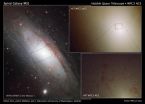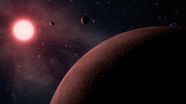(Press-News.org) Astronomers using the partially completed ALMA observatory have found compelling evidence for how star-forming galaxies evolve into 'red and dead' elliptical galaxies, catching a large group of galaxies right in the middle of this change.
For years, astronomers have been developing a picture of galaxy evolution in which mergers between spiral galaxies could explain why nearby large elliptical galaxies have so few young stars. The theoretical picture is chaotic and violent: The merging galaxies knock gas and dust into clumps of rapid star formation, called starbursts, and down into the maws of the supermassive black hole growing in the merger's core. As more and more matter heaves onto the black hole, powerful jets erupt, and the region around the black hole glows brilliantly as a quasar. The jets blowing out of the merger eventually plow out the galaxy's potential star-forming gas, ending the starbursts.
Until now, astronomers had never spotted enough mergers at this critical, jet-plowing stage to definitively link jet-driven outflows to the cessation of starburst activity. During its Early Science observations in late 2011, however, ALMA became the first telescope to confirm nearly two dozen galaxies in this brief stage of galaxy evolution.
What did ALMA actually see? "Despite ALMA's great sensitiviy to detecting starbursts, we saw nothing, or next to nothing - which is exactly what we hoped it would see," said lead investigator Dr. Carol Lonsdale of the North American ALMA Science Center at the National Radio Astronomy Observatory (NRAO) in Charlottesville, Virginia. Lonsdale presented the findings at the American Astronomical Society's meeting in Austin, Texas on behalf of an international team of astronomers.
For these observations, ALMA was tuned to look for dust warmed by active star-forming regions. However, half of Lonsdale's two dozen galaxies didn't show up at all in ALMA's observations, and the other half were extremely dim, indicating that there was very little of the tell-tale dust present.
"ALMA's results reveal to us that there is little-to-no starbursting going on in these young, active galaxies. The galaxy evolution model says this is thanks to their central black holes whose jets are starving them of star-forming gas," Lonsdale said. "On its first run out of the gate, ALMA confirmed a critical phase in the timeline of galaxy evolution."
Once their star-forming gas has been blown away, merging galaxies will be unable to make new stars. As the last generation of massive and brilliant, but short-lived, blue stars dies out, the long-lived, lower mass, redder stars come to dominate the merger's star population, giving the gas-starved galaxy an overall reddish hue over time.
A New Method for Finding Candidate Starving Galaxies
To support this gas-starvation theory, astronomers needed to see it at work in lots of merging galaxies with high power jets. The place to observe enough of them is among the quasars, active galaxies found in the Universe's past, several billion light-years away.
Lonsdale said, "The missing phase had to be among quasars that could be seen brightly in infrared and radio wavelengths -- mergers young enough to have their cores still swaddled in infrared-bright dust, but old enough that their black holes were well fed and producing jets observable in the radio."
Their selective hunt for these specific quasars started with NASA's Wide-field Infrared Survey Explorer (WISE) spacecraft, which has hundreds of millions of objects in its all-sky, infrared survey of the Universe. Lonsdale led WISE's quasar survey team that picked out the brightest, reddest objects this infrared telescope had mapped.
The team then compared its selections with NRAO's VLA Sky Survey of 1.8 million radio objects and chose the overlapping results as the most suitable targets for their search for starburst activities with ALMA. Observing at longer infrared wavelengths than WISE, ALMA enabled Lonsdale's team to discriminate between dust warmed by starburst activity and dust heated by material falling onto the central black hole.
ALMA has 26 more WISE quasars to probe before Lonsdale and her international team publish their results later this year. Meanwhile, she and her team will observe these galaxies, and over a hundred more, with NRAO's newly upgraded Karl G. Jansky Very Large Array (VLA).
"ALMA revealed to us this rare stage of galaxy starvation, and now we want to use the VLA to focus on delineating the outflows that robbed these galaxies of their fuel," Lonsdale said. "Together, the two most sensitive radio telescope arrays in the world will help us truly understand the fate of spiral galaxies like our own Milky Way."
###
The National Radio Astronomy Observatory is a facility of the National Science Foundation, operated under cooperative agreement by Associated Universities, Inc.
The Atacama Large Millimeter/submillimeter Array (ALMA), an international astronomy facility, is a partnership of Europe, North America and East Asia in cooperation with the Republic of Chile. ALMA is funded in Europe by the European Organization for Astronomical Research in the Southern Hemisphere (ESO), in North America by the U.S. National Science Foundation (NSF) in cooperation with the National Research Council of Canada (NRC) and the National Science Council of Taiwan (NSC) and in East Asia by the National Institutes of Natural Sciences (NINS) of Japan in cooperation with the Academia Sinica (AS) in Taiwan. ALMA construction and operations are led on behalf of Europe by ESO, on behalf of North America by the National Radio Astronomy Observatory (NRAO), which is managed by Associated Universities, Inc. (AUI) and on behalf of East Asia by the National Astronomical Observatory of Japan (NAOJ). The Joint ALMA Observatory (JAO) provides the unified leadership and management of the construction, commissioning and operation of ALMA.
END
A better understanding of the universe will be the outgrowth of the discovery of the Higgs boson, according to a team of University of Oklahoma researchers. The team predicts the discovery will lead to supersymmetry or SUSY—an extension of the standard model of particle physics. SUSY predicts new matter states or super partners for each matter particle already accounted for in the standard model. SUSY theory provides an important new step to a better understanding of the universe we live in.
Howard Baer, Homer L. Dodge Professor of High Energy Physics in the OU Department ...
Tropical Storm Heidi is forecast to make landfall today along the Pilbara coast of Western Australia as warnings pepper the coast. NASA's Aqua satellite passed overhead early in the day and captured a visible image showing Heidi's center still north of the Pilbara coast, while her outer bands continue to bring rainfall and gusty winds to coastal residents.
NASA's Aqua satellite passed over Heidi on January 11, 2012 at 02:30 UTC (Jan. 10 at 10:30 a.m. EST) and the Moderate Resolution Imaging Spectroradiometer captured a visible image of the storm. The image showed that ...
Peering deep inside the hub of the neighboring Andromeda galaxy, NASA's Hubble Space Telescope has uncovered a large, rare population of hot, bright stars.
Blue is typically an indicator of hot, young stars. In this case, however, the stellar oddities are aging, sun-like stars that have prematurely cast off their outer layers of material, exposing their extremely blue-hot cores.
Astronomers were surprised when they spotted these stars because physical models show that only an unusual type of old star can be as hot and as bright in ultraviolet light.
While Hubble has ...
A new Hubble Space Telescope image centers on the 100-million-solar-mass black hole at the hub of the neighboring spiral galaxy M31, or the Andromeda galaxy, the only galaxy outside the Milky Way visible to the naked eye and the only other giant galaxy in the local group.
This is the sharpest visible-light image ever made of the nucleus of an external galaxy.
The event horizon, the closest region around the black hole where light can still escape, is too small to be seen, but it lies near the middle of a compact cluster of blue stars at the center of the image. The ...
It's easy to pick up on the movements that other people make—scratching your head, crossing your legs. But a new study published in Psychological Science, a journal of the Association for Psychological Science, finds that people only feel the urge to mimic each other when they have the same goal.
It's common for people to pick up on each other's movements. "This is the notion that when you're having a conversation with somebody and you don't care where your hands are, and the other person scratches their head, you scratch your head," says Sasha Ondobaka of the Donders ...
SEATTLE – Among overweight and obese adults, a diet rich in slowly digested carbohydrates, such as whole grains, legumes and other high-fiber foods, significantly reduces markers of inflammation associated with chronic disease, according to a new study by Fred Hutchinson Cancer Research Center. Such a "low-glycemic-load" diet, which does not cause blood-glucose levels to spike, also increases a hormone that helps regulate the metabolism of fat and sugar. These findings are published online ahead of the February print issue of the Journal of Nutrition.
The controlled, ...
PASADENA, Calif. -- A team of astronomers led by scientists at the California Institute of Technology (Caltech) has discovered the three smallest confirmed planets ever detected outside our solar system. The three planets, which all orbit a single star, are smaller than Earth and appear to be rocky with a solid surface. Until now, astronomers have found at most only four other rocky planets, also called terrestrial planets, around other stars.
The trio of new planets is too close to the central star to be in its habitable zone—the ring-shaped region around a star where ...
Using NASA's Hubble Space Telescope, astronomers have solved a longstanding mystery on the type of star, or so-called progenitor, which caused a supernova seen in a nearby galaxy. The finding yields new observational data for pinpointing one of several scenarios that trigger such outbursts.
Based on previous observations from ground-based telescopes, astronomers knew the supernova class, called a Type Ia, created a remnant named SNR 0509-67.5, which lies 170,000 light-years away in the Large Magellanic Cloud galaxy.
Theoretically, this kind of supernova explosion is ...
Important new information on one of the most critical protein machines in living cells has been reported by a team of researchers with the U.S. Department of Energy's Lawrence Berkeley National Laboratory (Berkeley Lab) and the University of California (UC) Berkeley. The researchers have provided the most detailed look ever at the "regulatory particle" used by the protein machines known as proteasomes to identify and degrade proteins that have been marked for destruction. The activities controlled by this regulatory particle are critical to the quality control of cellular ...
January 11, 2012 -- New research conducted in the Center for Infection and Immunity (CII) at Columbia University's Mailman School of Public Health, reports that children with autism and gastrointestinal disturbances have high levels of a bacterium called Sutterella in their intestines.
Study findings are published online in the journal mBio.
The investigators found that over half of the children diagnosed with autism and gastrointestinal disturbances had Sutterella in intestinal biopsy tissue, while Sutterella was absent in biopsies from typically developing children ...





